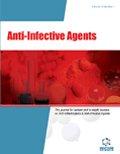Abstract
Pine needles are used in folk medicine to treat liver disease, gastrointestinal diseases, nervous system disease, circulatory diseases, and skin problems. The present study was to evaluate the antibacterial activity of methanol (MeOH) extract of pine needles against some cariogenic and periodontal bacteria. The chekerboard and time-kill tests were used for the combined evaluations. The MIC and MBC values for MeOH extract against all tested oral bacteria were in the ranges 0.25-4 mg/mL and 1-16 mg/mL, respectively. The range of MIC50 and MIC90 of MeOH extract was 0.0625-2 mg/mL and 1-16 mg/mL, respectively. Significant synergies were observed by the MeOH extract with ampicillin or gentamicin combinations at FICI ranged all 0.5. Furthermore, 2-6 hours of treatment with 1/2 MIC of MeOH extract with 1/2 MIC of antibiotics resulted in an increase in the rate of killing in units of CFU/ml to a greater degree than was observed with MeOH extract alone. These results demonstrated that MeOH extract of pine needles enhanced the efficacy of ampicillin and gentamicin in vitro, which had potential for combinatory therapy of patients infected with oral pathogens.
Keywords: Antibacterial activity, minimum bactericidal concentrations, minimum inhibitory concentrations, synergistic effect, pine needle (Pinus densiflora).
Anti-Infective Agents
Title:Synergism between Methanol Extract of Pine Needles and Antibiotics Against Oral Pathogens
Volume: 11 Issue: 2
Author(s): Mi-Ran Jeong, Sung-Mi Choi, Jeong H. Park and Jeong-Dan Cha
Affiliation:
Keywords: Antibacterial activity, minimum bactericidal concentrations, minimum inhibitory concentrations, synergistic effect, pine needle (Pinus densiflora).
Abstract: Pine needles are used in folk medicine to treat liver disease, gastrointestinal diseases, nervous system disease, circulatory diseases, and skin problems. The present study was to evaluate the antibacterial activity of methanol (MeOH) extract of pine needles against some cariogenic and periodontal bacteria. The chekerboard and time-kill tests were used for the combined evaluations. The MIC and MBC values for MeOH extract against all tested oral bacteria were in the ranges 0.25-4 mg/mL and 1-16 mg/mL, respectively. The range of MIC50 and MIC90 of MeOH extract was 0.0625-2 mg/mL and 1-16 mg/mL, respectively. Significant synergies were observed by the MeOH extract with ampicillin or gentamicin combinations at FICI ranged all 0.5. Furthermore, 2-6 hours of treatment with 1/2 MIC of MeOH extract with 1/2 MIC of antibiotics resulted in an increase in the rate of killing in units of CFU/ml to a greater degree than was observed with MeOH extract alone. These results demonstrated that MeOH extract of pine needles enhanced the efficacy of ampicillin and gentamicin in vitro, which had potential for combinatory therapy of patients infected with oral pathogens.
Export Options
About this article
Cite this article as:
Jeong Mi-Ran, Choi Sung-Mi, H. Park Jeong and Cha Jeong-Dan, Synergism between Methanol Extract of Pine Needles and Antibiotics Against Oral Pathogens, Anti-Infective Agents 2013; 11 (2) . https://dx.doi.org/10.2174/2211352511311020008
| DOI https://dx.doi.org/10.2174/2211352511311020008 |
Print ISSN 2211-3525 |
| Publisher Name Bentham Science Publisher |
Online ISSN 2211-3533 |
 19
19
- Author Guidelines
- Bentham Author Support Services (BASS)
- Graphical Abstracts
- Fabricating and Stating False Information
- Research Misconduct
- Post Publication Discussions and Corrections
- Publishing Ethics and Rectitude
- Increase Visibility of Your Article
- Archiving Policies
- Peer Review Workflow
- Order Your Article Before Print
- Promote Your Article
- Manuscript Transfer Facility
- Editorial Policies
- Allegations from Whistleblowers
- Announcements
Related Articles
-
Anti-Platelet Treatment of Middle-Sized Abdominal Aortic Aneurysms
Current Vascular Pharmacology Advances in Biotechnology for Tissue Engineering of Bone
Current Pharmaceutical Biotechnology Histone Deacetylase Inhibitors In Inflammatory Disease
Current Topics in Medicinal Chemistry A Review of Light Sources and Enhanced Targeting for Photodynamic Therapy
Current Medicinal Chemistry Potential Use of Polymeric Nanoparticles for Drug Delivery Across the Blood-Brain Barrier
Current Medicinal Chemistry Recent Patents Regarding Essential Oils and the Significance of their Constituents in Human Health and Treatment
Recent Patents on Anti-Infective Drug Discovery Human Amniotic Membrane: Clinical Uses, Patents And Marketed Products
Recent Patents on Regenerative Medicine Photodynamic Therapy and Periodontal Treatment
Clinical Anti-Inflammatory & Anti-Allergy Drugs (Discontinued) The Emerging Landscapes to Drug Delivery Systems for the Treatment of Pancreatic Cancer
Current Medicinal Chemistry Determination of Homocysteine in Human Saliva by Liquid Chromatography and Electrospray Ionization Quadrupole Time-of-flight Mass Spectrometry: Profiles in Healthy Adults
Protein & Peptide Letters Oral Hygiene and Ventilator-Associated Pneumonia
Current Respiratory Medicine Reviews Mucoadhesive Polymers for Delivery of Drugs to the Oral Cavity
Recent Patents on Drug Delivery & Formulation The Nervous System as a Critical Regulator of Immune Responses Underlying Allergy
Current Pharmaceutical Design Novel Devices to Prevent Membrane Perforation in Transcrestal Sinus Floor Augmentation Surgery
Recent Patents on Biomedical Engineering (Discontinued) Current Patents on Osteoinductive Molecules for Bone Tissue Engineering
Recent Patents on Biomedical Engineering (Discontinued) Transcriptional Regulation of mPGES1 in Cancer: An Alternative Approach to Drug Discovery?
Current Drug Targets Drug Interactions During Periodontal Therapy in HIV-Infected Subjects
Mini-Reviews in Medicinal Chemistry Treatment for Cancer Patients with Oral Mucositis: Assessment Based on the Mucositis Study Group of the Multinational Association of Supportive Care in Cancer in International Society of Oral Oncology (MASCC/ISOO) in 2013 and Proposal of Possible Novel Treatment with a Japanese Herbal Medicine
Current Pharmaceutical Design Clinical Outcomes for Severe Early Childhood Caries
Current Pediatric Reviews Effects of Sublingual Immunotherapy on Allergic Inflammation: An Update
Inflammation & Allergy - Drug Targets (Discontinued)


























